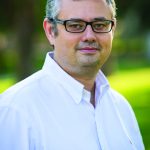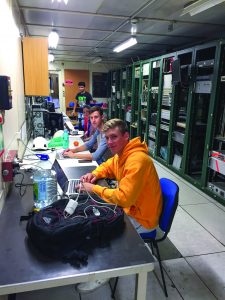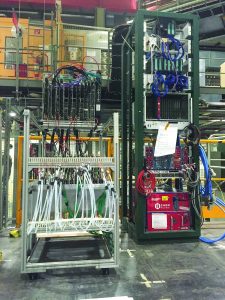During the Summer of 2018, Three Cal Lutheran Physics Undergraduates Accompanied Their Professor to Cern—the European Organization for Nuclear Research Located in Geneva, Switzerland. There, They Took Part in the Particle Physics Experiment Called the Compact Muon* Soleoid (Cms)— One of the Largest International Scientific Collaborations in History.
“We are looking for yet-undetected ‘super- symmetric particles,’” said Sebastian
Carron Montero, assistant professor of physics at Cal Lutheran, “predicted by so-called Grand Unification Theories,
which seek to unify the known fundamental forces into a single theory.” This is one of the central questions in physics, and physicists have been searching for evidence for these particles for decades. The best chances to find evidence currently lie at the CMS and ATLAS experiments at the Large Hadron Collider at CERN, the largest and most powerful energy particle accelerator in the world.
Carron Montero and his students are working collaboratively with University
of California, Santa Barbara (UCSB) and other research institutions around the world on detector improvements, which will position the CMS to answer questions that have stumped and divided physicists, including what elementary particles make up dark matter. The group’s current goal is a multi-institution project, known as the High Granularity Calorimeter (HGCal) upgrade, to improve a section of the onion-layered CMS by replacing its light-sensitive components with a series of silicon-based detectors to enable more precise particle energy measurements.
Breadth of Cal Lutheran Research
For the past three years, Carron Montero and his students have been centrally involved in electronic design, manufacture and testing of prototypes. The HGCal upgrade will be the first silicon-based particle calorimeter for High Energy Physics designed in the world.
Cal Lutheran students prepared for their time at CERN by taking courses on quantum mechanics and particle physics. They also worked with Carron Montero and the High Energy Physics Group at UCSB to manufacture and test detector prototypes.
The students have been instrumental in the testing phase, helping uncover a few early design flaws. During the summer of 2018 at CERN, they tested the latest version modules under real beam conditions. They exposed the detector to calibrated electron, muon and pion (a hadron composed of two quarks**) beams.
Hend Kordy’s ‘20 group tested the performance of the silicon- based detectors by measuring real particles in energetic accelerator conditions. “We collected runs for different energy levels for electrons and muons, while observing environmental conditions such as temperature and humidity level,” she said.
“We were delighted to see our modules responding as expected, yielding beautiful reconstructions of particle showers,” explained Carron Montero. “This was a remarkable result for a project in such an early stage in development.”
Johann Dias ‘20 helped work on the data analysis of test beam results and is currently involved in creating a prototype silicon photo-multiplier scintillator.
*A muon is an unstable subatomic particle, with a mass 200 times greater than an electron, which makes up much of the cosmic radiation reaching the Earth’s surface.
**A quark is a type of elementary particle and a fundamental constituent of matter. Quarks combine to form composite particles called hadrons, the most stable of which are protons and neutrons, the components of atomic nuclei.
Benefits for Student Researchers
The students are not only learning about fundamental particle physics. They are also being trained in a number of technical
skills: precision measurements, software development, electronics development, data acquisition systems, data analysis statistical techniques and artificial intelligence algorithms for sorting large volumes of data.
“This is quite an advanced training that should give them a significant competitive advantage when applying to graduate school or technology-related industry jobs,” Carron Montero said. “Our students learn to work as a team, and are in frequent contact with professors, post- docs, and graduate and undergraduate students from leading institutions around the world. They are creating a network of contacts that should be very beneficial for their futures.”
Being at CMS opened my eyes to endless possibilities of scientific achievements through human collaboration.
The CERN experience affected Kordy’s career goal. “A huge part of the research is based on programming. And since that was the part I enjoyed the most, it encouraged me to double major in physics and computer science.”
Sitting in on team meetings was a defining moment in Dias’ physics career. “I was humbled sitting alongside some of the brightest minds in the world. Being at CMS opened my eyes to endless possibilities of scientific achievements through human collaboration.”



